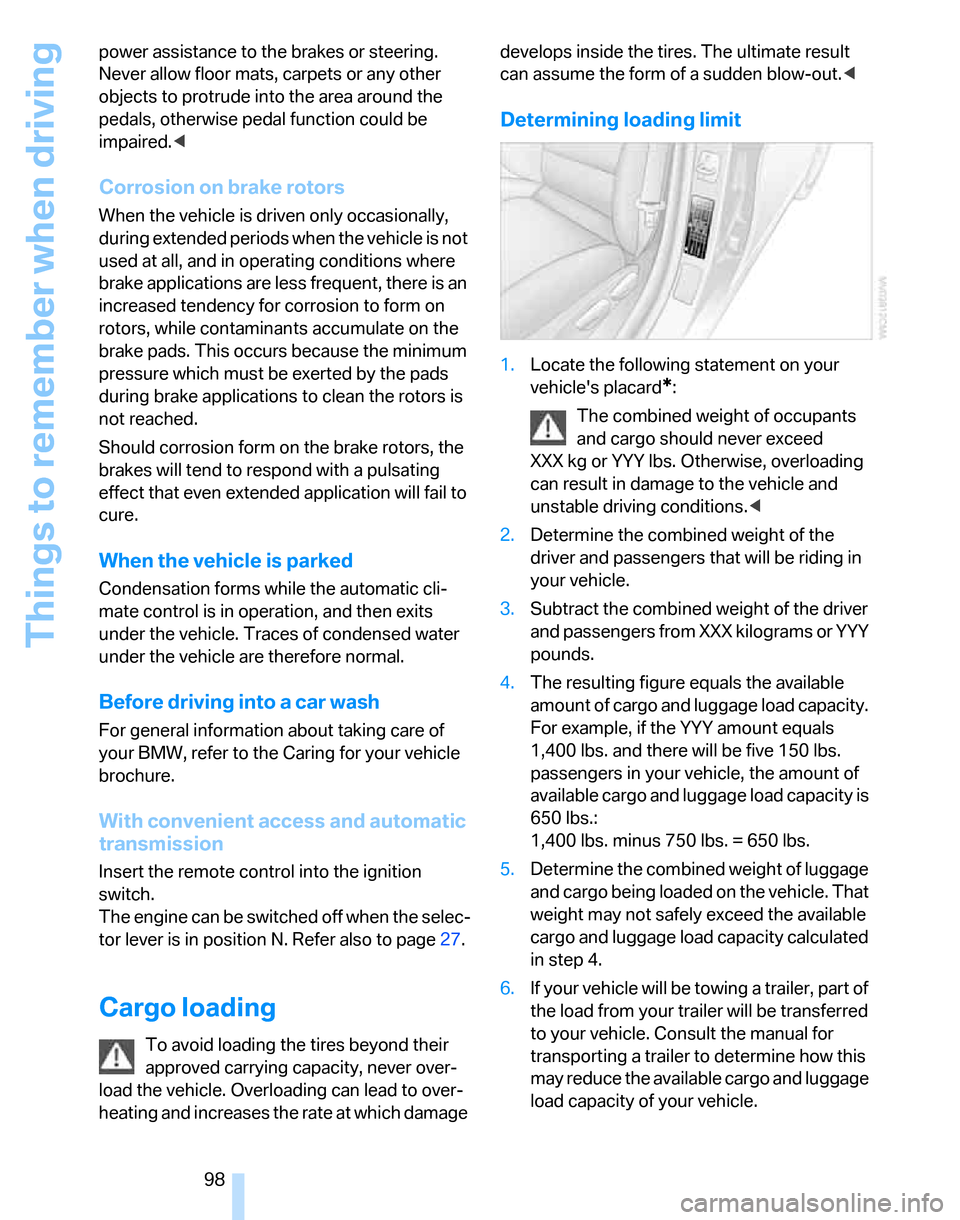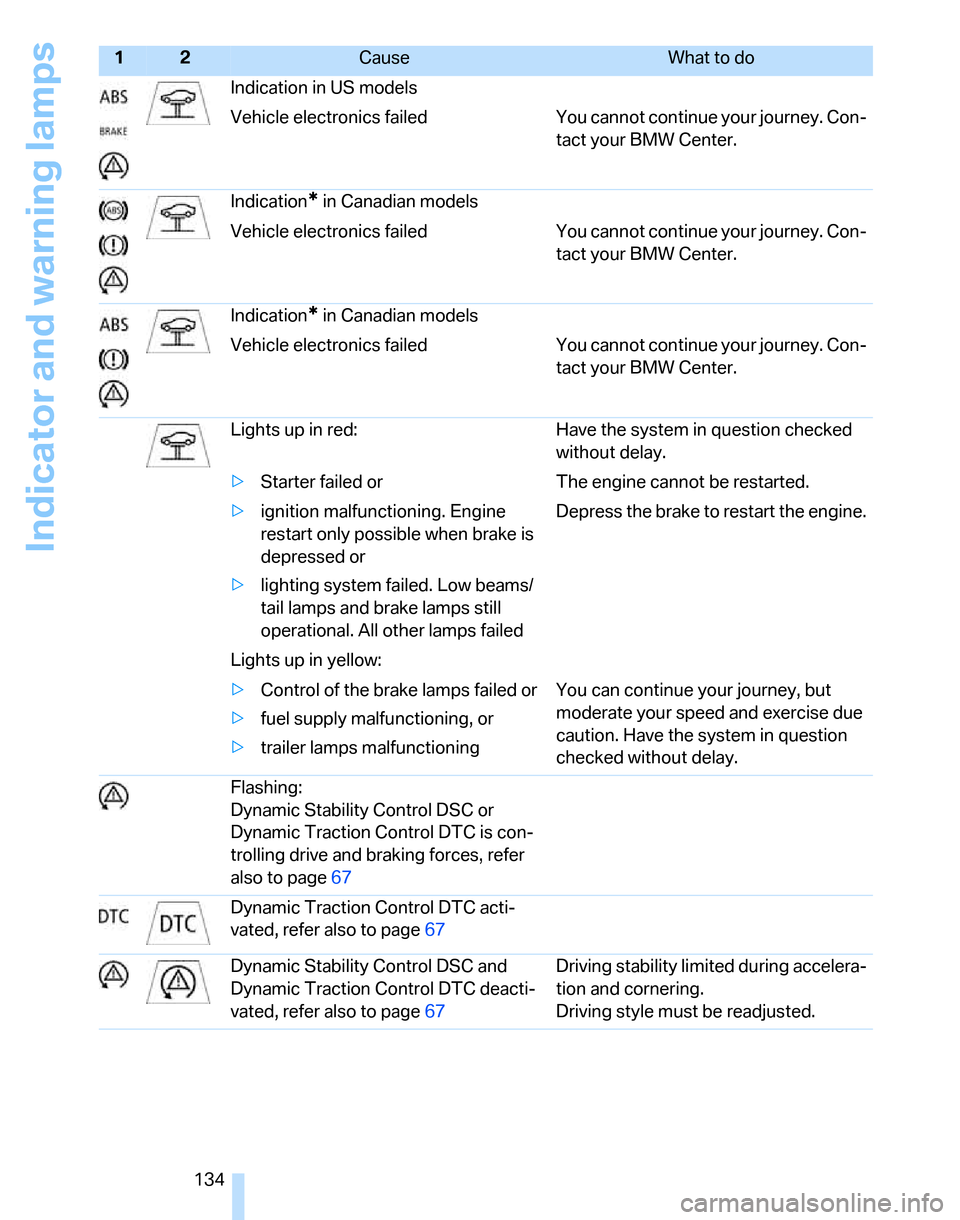2006 BMW 325XI TOURING trailer
[x] Cancel search: trailerPage 67 of 160

Reference
At a glance
Controls
Driving tips
Mobility
65
Technology for driving comfort and safety
PDC Park Distance Control*
The concept
The PDC assists you with maneuvering in tight
parking spaces. Acoustic signals warn you of
the presence of an object in front of
* or behind
your car. To measure the distance, there are
four ultrasonic sensors in each bumper.
An acoustic warning sounds once an object is
closer than approx. 2 ft/60 cm to the front sen-
sors
* or both rear corner sensors, or closer than
approx. 5 ft/1.50 m to the rear center sensors.
PDC is a parking aid that can indicate
objects when they are approached
slowly, as is usually the case when parking.
Avoid approaching an objec t a t h i g h s p e e d , o t h -
erwise physical circumstances may lead to the
system warning being issued too late.<
Automatic mode
With the engine running or the ignition switched
on, the system is activated automatically after
approx. 1 second when you engage reverse
gear or move the automatic transmission selec-
tor lever to position R. Wait this short period
before driving.
Switching on manually
Press the button, the LED lights up.
Switching off manually
Press the button again; the LED goes out.The system is automatically deactivated once
the vehicle travels approx. 165 ft/50 m or
exceeds a speed of approx. 20 mph or 30 km/h;
the LED goes out. You can reactivate the sys-
tem as needed.
Signal tones
When nearing an object, its position is indicated
correspondingly by an interval tone. For exam-
ple, the tone sounds at the rear if the system
detects an object behind the car. As the dis-
tance between vehicle and object decreases,
the intervals between the tones become
shorter. If the distance to the nearest object
falls to below roughly 1 ft/30 cm, then a contin-
uous tone sounds.
The warning signal is canceled after approx.
3 seconds, if you are moving parallel to a wall.
Malfunction
The indicator lamp in the instrument
cluster comes on. PDC is malfunc-
tioning. Have the system checked.
To avoid this problem, keep the sensors clean
and free of ice or snow in order to ensure that
they will continue to operate effectively. When
using a high-pressure cleaner, do not spray the
sensors for extended periods of time and only
from a distance of at least 4 in/10 cm.
Manual mode
The LED above the button flashes in addition.
System limitations
Even with PDC, final responsibility for
estimating the distance between the
vehicle and any obstructions always remains
with the driver. Even when sensors are pro-
vided, there is a blind spot in which objects can
no longer be detected. The system is also sub-
ject to the physical limits that apply to all forms
of ultrasonic measurement, such as those
encountered with trailer towbars and couplings,
Page 100 of 160

Things to remember when driving
98 power assistance to the brakes or steering.
Never allow floor mats, carpets or any other
objects to protrude into the area around the
pedals, otherwise pedal function could be
impaired.<
Corrosion on brake rotors
When the vehicle is driven only occasionally,
during extended periods when the vehicle is not
used at all, and in operating conditions where
brake applications are less frequent, there is an
increased tendency for corrosion to form on
rotors, while contaminants accumulate on the
brake pads. This occurs because the minimum
pressure which must be exerted by the pads
during brake applications to clean the rotors is
not reached.
Should corrosion form on the brake rotors, the
brakes will tend to respond with a pulsating
effect that even extended application will fail to
cure.
When the vehicle is parked
Condensation forms while the automatic cli-
mate control is in operation, and then exits
under the vehicle. Traces of condensed water
under the vehicle are therefore normal.
Before driving into a car wash
For general information about taking care of
your BMW, refer to the Caring for your vehicle
brochure.
With convenient access and automatic
transmission
Insert the remote control into the ignition
switch.
The engine can be switched off when the selec-
tor lever is in position N. Refer also to page27.
Cargo loading
To avoid loading the tires beyond their
approved carrying capacity, never over-
load the vehicle. Overloading can lead to over-
heating and increases the rate at which damage develops inside the tires. The ultimate result
can assume the form of a sudden blow-out.<
Determining loading limit
1.Locate the following statement on your
vehicle's placard
*:
The combined weight of occupants
and cargo should never exceed
XXX kg or YYY lbs. Otherwise, overloading
can result in damage to the vehicle and
unstable driving conditions.<
2.Determine the combined weight of the
driver and passengers that will be riding in
your vehicle.
3.Subtract the combined weight of the driver
and passengers from XXX kilograms or YYY
pounds.
4.The resulting figure equals the available
amount of cargo and luggage load capacity.
For example, if the YYY amount equals
1,400 lbs. and there will be five 150 lbs.
passengers in your vehicle, the amount of
available cargo and luggage load capacity is
650 lbs.:
1,400 lbs. minus 750 lbs. = 650 lbs.
5.Determine the combined weight of luggage
and cargo being loaded on the vehicle. That
weight may not safely exceed the available
cargo and luggage load capacity calculated
in step 4.
6.If your vehicle will be towing a trailer, part of
the load from your trailer will be transferred
to your vehicle. Consult the manual for
transporting a trailer to determine how this
may reduce the available cargo and luggage
load capacity of your vehicle.
Page 136 of 160

Indicator and warning lamps
134Indication in US models
Vehicle electronics failed You cannot continue your journey. Con-
tact your BMW Center.
Indication
* in Canadian models
Vehicle electronics failed You cannot continue your journey. Con-
tact your BMW Center.
Indication
* in Canadian models
Vehicle electronics failed You cannot continue your journey. Con-
tact your BMW Center.
Lights up in red: Have the system in question checked
without delay.
>Starter failed or The engine cannot be restarted.
>ignition malfunctioning. Engine
restart only possible when brake is
depressed or
>lighting system failed. Low beams/
tail lamps and brake lamps still
operational. All other lamps failedDepress the brake to restart the engine.
Lights up in yellow:
>Control of the brake lamps failed or
>fuel supply malfunctioning, or
>trailer lamps malfunctioning You can continue your journey, but
moderate your speed and exercise due
caution. Have the system in question
checked without delay.
Flashing:
Dynamic Stability Control DSC or
Dynamic Traction Control DTC is con-
trolling drive and braking forces, refer
also to page67
Dynamic Traction Control DTC acti-
vated, refer also to page67
Dynamic Stability Control DSC and
Dynamic Traction Control DTC deacti-
vated, refer also to page67Driving stability limited during accelera-
tion and cornering.
Driving style must be readjusted.
12Cause What to do
Page 157 of 160

Reference
At a glance
Controls
Driving tips
Mobility
155
Tank contents, refer to
Capacities145
Technical data142
Technical modifications5
Telephone
– installation location, refer to
Center armrest87
– refer to separate Owner's
Manual
Temperature adjustments
– air conditioner79
– automatic climate control81
Temperature display
– ice warning57
– outside temperature57
– setting the units60
Temperature of the coolant,
refer to Coolant
temperature57
Tensioning straps, refer to
Securing cargo99
The individual vehicle5
Thigh support33
Third brake lamp, refer to
Center brake lamp123
Tilt alarm sensor25
Tilt function, passenger-side
mirror37
Tire inflation pressures106
Tire pressure
– loss70
Tire pressure monitoring,
refer to Flat Tire Monitor69
Tire puncture, refer to Flat Tire
Monitor70
Tire Quality Grading108Tires
– age108,110
– breaking in96
– changing, refer to Changing
wheels123
– condition109
– damage109
– inflation pressure106
– minimum tread depth109
– new tires110
– pressure monitoring, refer to
Flat Tire Monitor69
– puncture70
– Run-Flat Tires110
– size108
– wear indicators, refer to
Minimum tread depth109
– winter tires111
Tools, refer to Onboard tool
kit119
Torque142
Tow bar128
Tow fitting
– screw thread127
Tow fittings127
Tow fittings for tow-starting
and towing away127
Towing127
– methods128
Towing away
– car with automatic
transmission127
Tow rope128
Tow-starting127
– sequential manual gearbox
SMG128
Track width, refer to
Dimensions143
Traction-assist feature, refer
to DSC66
Traction control, refer to DSC
Dynamic Stability
Control66
Trailer towing
– towing loads and gross
weight144Transmission
– automatic transmission with
Steptronic44
– manual transmission44
– overriding selector lever lock
for automatic transmission
with Steptronic46
Transporting children
safely39
Transport securing device,
refer to Securing cargo99
Tread depth, refer to Minimum
tire tread109
Trip-distance counter, refer to
Trip odometer57
Triple turn signal activation46
Trip odometer57
Trunk lamp, refer to Cargo
area lamp77
Trunk lid, refer to Tailgate23
Turning circle, refer to
Dimensions143
Turn signals46
– indicator lamp12
– replacing bulbs121
Tying down loads, refer to
Cargo loading99
U
Underbody protection, refer to
Caring for your vehicle
brochure
Uniform Tire Quality Grading/
UTQR108
Units
– average consumption60
– temperature60
Universal garage door opener,
refer to Integrated universal
remote control84
Universal remote control84
Unlatching, refer to
Unlocking26